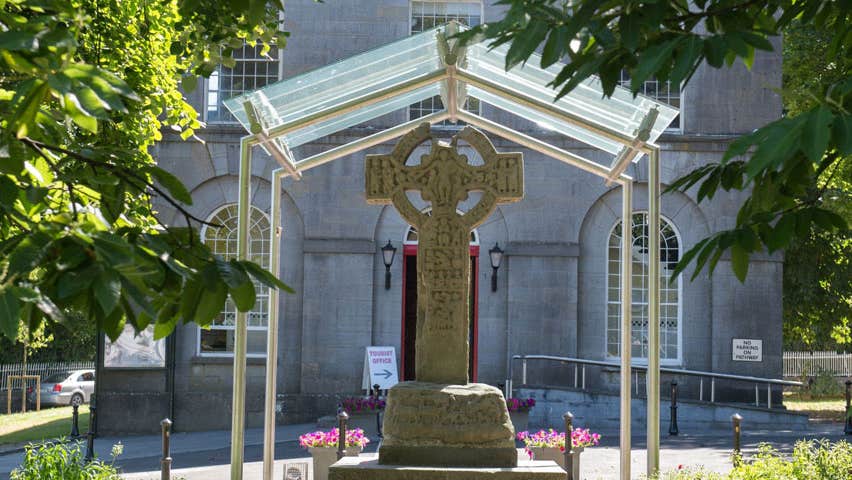

The town of Kells in County Meath, Ireland, is renowned for its rich history, deeply intertwined with early Irish Christianity. Among its treasures are the Kells High Crosses, towering stone monuments that beautifully blend religious devotion and artistic craftsmanship. These crosses, dating back to the 9th and 10th centuries, serve as lasting reminders of Ireland’s Golden Age of Monasticism.
Whether you’re a history enthusiast, an art lover, or a pilgrim tracing Ireland’s spiritual heritage, the high crosses of Kells offer a journey into the past that is as inspiring as it is enlightening.
How Many High Crosses Are in Kells?
Kells is home to four high crosses, though only three remain largely intact today. These crosses—The Cross of Patrick and Columba, The West Cross, The South Cross, and The North Cross—are all located within the grounds of St. Columba’s Church. Each cross is a masterpiece, adorned with intricate carvings that depict scenes from the Bible, reflecting both religious teachings and the remarkable artistic talent of the early Christian monks who created them.
Why Did Monks Carve Scenes from the Bible on High Crosses?
The high crosses of Ireland were more than decorative monuments; they were teaching tools. In an era when literacy was limited, monks carved biblical scenes on the crosses to visually communicate stories of faith, morality, and salvation. The carvings served as “sermons in stone,” enabling communities to learn and reflect on their faith through art.
The Kells High Crosses are excellent examples of this tradition. They feature detailed depictions of biblical narratives, including the Crucifixion, the Last Judgment, and the Fall of Man, blending storytelling with devotion.
What Is the Meaning of the Celtic High Cross?
The Celtic high cross is one of the most iconic symbols of Ireland’s Christian heritage. Its defining feature is the circular ring connecting the arms of the cross, often interpreted as a representation of eternity, unity, or the halo of Christ. The high crosses stand as markers of faith and community, often placed in monastic settings or at significant crossroads to serve as spiritual beacons.
Kells High Crosses History
The history of the Kells high crosses is deeply connected to the monastic settlement established by St. Columba in the 6th century. Kells became a prominent religious center, and its high crosses were likely erected as symbols of the monastery’s influence and devotion. Over the centuries, these crosses have endured, weathering time and the elements, to remain as powerful reminders of Ireland’s monastic achievements.
For visitors, understanding the Kells high crosses history adds layers of appreciation for their intricate carvings and enduring presence. A Kells high crosses map is available at the site to help locate and interpret the crosses during your visit.
Famous High Crosses in Ireland
While the Kells High Crosses are undoubtedly significant, other high crosses across Ireland have achieved legendary status. The High Cross of Muiredach at Monasterboice is often regarded as the finest high cross in Ireland, celebrated for its intricate carvings and the remarkable detail of its biblical scenes. Its panels include vivid depictions of the Last Judgment and Christ in Majesty, offering profound insights into the spiritual and artistic life of early Ireland.
For those visiting Kells, a trip to Monasterboice High Crosses is a worthwhile addition, as it complements the experience of exploring Ireland’s Christian heritage.
Where Are the Original High Crosses on Display?
To protect these ancient treasures from weathering, some original high crosses have been relocated to indoor settings. The original crosses from Monasterboice, for instance, are now housed in the nearby visitor center. However, the Kells High Crosses remain in situ, allowing visitors to experience them in their original monastic setting.
Kells High Crosses Opening Hours and Practical Information
- Opening Hours: The grounds of St. Columba’s Church, where the crosses are located, are open to the public during daylight hours.
- Admission: There is no fee to visit the Kells High Crosses, though donations for the upkeep of the site are appreciated.
- Access: A Kells high crosses map can be obtained locally to guide your exploration of the site.
A Spiritual and Historical Legacy
The Kells High Crosses are part of a broader tradition that places Ireland at the heart of early Christian art and spirituality. They stand alongside other remarkable landmarks like Brú na Bóinne and the Hill of Tara, offering a holistic view of Ireland’s rich heritage.
Tips for Visiting the Kells High Crosses
- Pair Your Visit: Combine your trip to Kells with a visit to nearby sites like Loughcrew Cairns and Monasterboice High Crosses for a deeper understanding of Ireland’s monastic history.
- Take Your Time: Spend time studying the carvings to appreciate their detail and meaning fully.
- Visit Local Attractions: Kells itself is a charming town with a strong historical vibe, offering plenty to explore beyond the high crosses.
Conclusion: Kells High Crosses—Timeless Testaments to Ireland’s Faith and Art
The Kells High Crosses are not merely relics of the past—they are profound statements of faith, creativity, and resilience. As you stand before these ancient monuments, you’re not just looking at stone carvings but connecting with a spiritual tradition that has endured for over a thousand years.
Whether you’re captivated by their artistic beauty, intrigued by their biblical storytelling, or inspired by their spiritual significance, the Kells High Crosses offer an unforgettable journey into the heart of Ireland’s Christian heritage. Let their timeless presence guide your exploration of Ireland’s ancient wonders.



